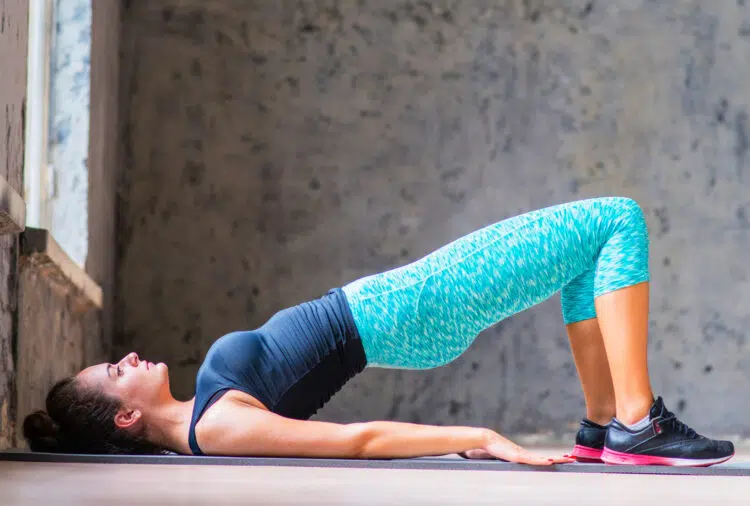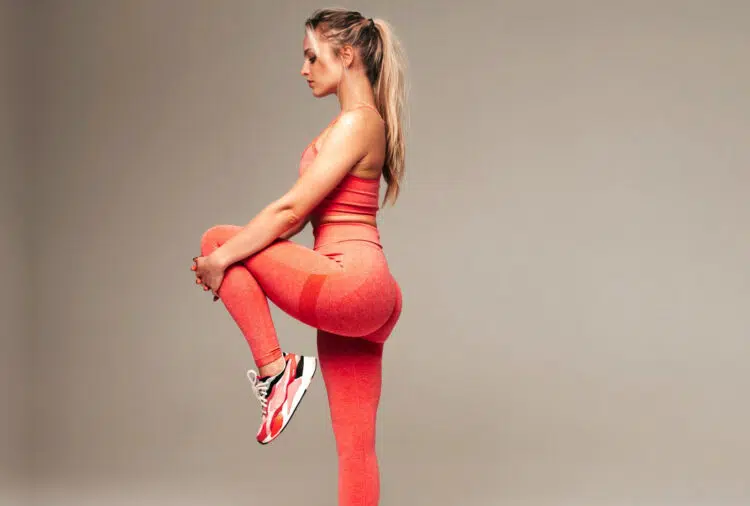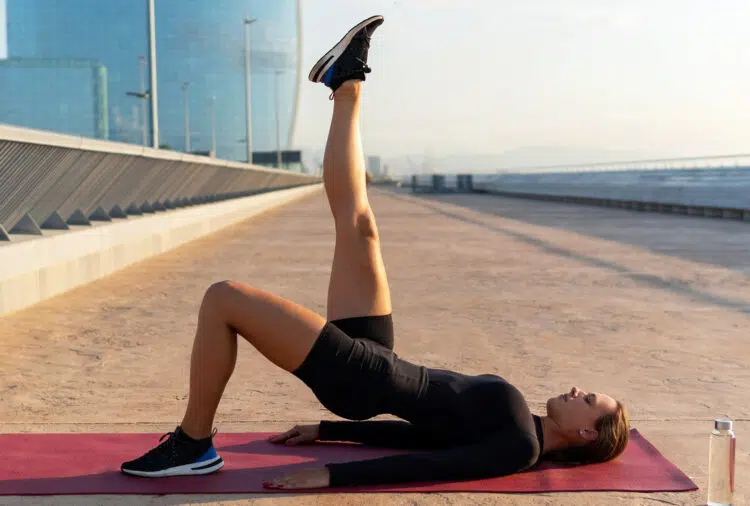As a veteran personal trainer who has worked with hundreds of clients, I know strength training can be intimidating, which is why most people postpone starting their transformation journey.
As you gain more training experience, it is easy to lose a beginner’s perspective. For instance, you might fly through a set of 10 push-ups, but attempting this exercise in a room full of fit people is very daunting for an overweight individual.
Most exercises labeled ‘beginner-friendly’ aren’t exactly that. Dips, pull-ups (even assisted), air squats, and lunges are all complex movements that come with a steep learning curve. Plus, performing these exercises with a lousy form can cause injury.
Beginners need a low-impact exercise that is easy to learn, targets the biggest muscle groups, and helps develop a robust mind-muscle connection. Enter — the glute bridge.

Glute bridges are an isolation floor exercise that primarily targets the glutes. However, it also engages the hamstring and core muscles. The biomechanics of this exercise are straightforward enough that most beginners can get a hold of them within a single session.
Level Up Your Fitness: Join our 💪 strong community in Fitness Volt Newsletter. Get daily inspiration, expert-backed workouts, nutrition tips, the latest in strength sports, and the support you need to reach your goals. Subscribe for free!
Furthermore, glute bridges have incredible loading potential, making them excellent for people of all experience levels. I took on a 30-day 100-glute bridges a-day challenge to experience the transformative power of this exercise. In this article, I share seven benefits you can expect from adopting this challenge.
How To Perform Glute Bridges
Before we get into the seven surprising changes you can expect on this challenge, let’s quickly touch upon how to perform this exercise for the best results:
- Lie supine on the floor with your arms at your sides and hands on the floor.
- Bend your knees and place your feet flat on the ground.
- Take a deep breath, brace your core, and lift your hips toward the ceiling as high as possible while driving your heels into the floor. Lift your toes off the floor during the concentric phase for a more extended range of motion (ROM).
- Your body, from the shoulders to the knees, should be in a straight line at the top.
- Slowly lower your hips toward the floor.
- Repeat for recommended reps.
Coach Tip: Focus on contracting your glutes throughout the ROM. Plus, experiment with different foot positions (narrow and wide) to maximize glute fiber stimulation.
1. Sculpted Glutes and Legs
Glutes are the biggest and most powerful muscle group in our body. This means two things — first, training the glutes can be very energy-intensive. Second, overlooking glute training can cause several issues.
Glute bridges are an isolation exercise that primarily involves the hip joint and allows you to focus on the gluteus maximus — the biggest of the three glute muscles. The gluteus medius and minimus are the other two glute muscles.
Performing 100 glute bridges daily for 30 days is enough training volume to improve lower body muscle tone and definition. Remember, focus on performing each rep with a perfect form to get the best bang for your buck.
Perform between eight to 30 reps of glute bridges in each set to maximize glute fiber stimulation and muscle tissue growth (1). After doing 100 glute bridges daily for a month, I noticed a significant improvement in my glute firmness, hamstring shape, and overall lower body aesthetics.
That said, training is just one aspect of building muscle. When you perform glute bridges, you create tiny muscle fiber tears. You need a well-balanced diet and enough rest time to recover and grow bigger and stronger muscles.
Coach Tip: As you gain more experience, you can turn up the training volume and intensity by using additional resistance, doing more reps each set, or shortening the rest time between sets to ensure consistent progress.
2. A Stronger Core and Improved Posture
Think of your legs as the foundation of your body. Just like a building’s structural integrity would be compromised if it has a weak foundation, the same goes for your body.
Weak glutes and an unstable core can make you look like the Leaning Tower of Pisa. But the sad news is that it won’t make you the world’s eighth wonder. However, you might find undesired fame on Instagram or TikTok.
“Many people have weak glutes and overactive quads, which can lead to posture problems and injuries,” explains personal trainer Adam Sinicki. He adds that glute bridges can help fix this issue.
Glute bridges work all the core muscles, which helps take pressure off the lower back and might help ease aches and pains. Some of my clients who have tried this challenge report feeling less tension in their shoulders and neck, improving their posture and self-confidence.
3. Boosted Athletic Performance
The glutes play a major role in several essential factors like posture, movement, exercises, and stability.
Glutes help propel you forward. During the final phase of doing 100 daily glute bridges, I noticed a significant improvement in my lower body explosiveness. My push-off during running was more powerful, and I hit a one-mile pace PR. (2)
This can carry over to other sports, like basketball, which involves vertical leaps. It goes without saying that this exercise will maximize your lower body strength training performance and prime you to hit PRs on exercises like squats, deadlifts, clean, and snatches.
Not only that, but strong glutes can also improve your everyday functionality, like climbing the stairs or carrying groceries.
Level Up Your Fitness: Join our 💪 strong community in Fitness Volt Newsletter. Get daily inspiration, expert-backed workouts, nutrition tips, the latest in strength sports, and the support you need to reach your goals. Subscribe for free!
4. Enhanced Hip Mobility and Flexibility
Hip mobility is one of the most underrated aspects of fitness. You don’t fully realize their importance until you start losing hip function. Poor hip mobility can hamper your athletic performance and every task, such as bending over to tie your shoes.
However, doing 100 glute bridges daily can do wonders for your hip flexibility. This exercise is especially important for people who spend most of their day seated. Glute bridges engage and loosen the hip flexor muscles, which are usually the culprit behind limited mobility.
Pausing briefly in the fully shortened position can help negate and counter gluteal amnesia. However, people dealing with existing health issues must consult a physician before starting a new training program.

5. Reduced Lower Back Pain
Contrary to what most people think, lower back pain isn’t always about the lower back. Weak glutes can be a major contributor to your back issues. Since the glutes are the biggest muscle in the body, neglecting training and strengthening them can set off a negative chain of events as the surrounding muscles have to fill in for the glutes.
Not addressing these issues can cause muscle imbalances, which can lead to strain, tightness, and aches in the lower back.
Since the glute bridges are a low-impact exercise, adding them to your routine can help strengthen the glutes and relieve the supporting muscles.
Furthermore, strong glutes lower the risk of lower body muscle and strength imbalance, which can limit the possibility of injuries.
6. Improved Mind-Body Connection
Most people can never develop a sculpted derrière because they lack a robust mind-muscle connection. Compound exercises like squats, lunges, and leg presses make it more challenging to develop a mind-muscle connection.
On the flip side, single-joint isolation exercises like glute bridges allow you to focus on one muscle at a time, which makes contracting the target muscle throughout the ROM easier. This results in better muscle stimulation and growth.
7. A Metabolic Boost and Increased Calorie Burning
This is one of the biggest improvements I noticed after completing the 100 glute bridges daily challenge. Since I did this challenge alongside my normal training routine, my workload multiplied overnight, pushing my metabolic rate through the stratosphere.
The high training volume increased my excess post-exercise oxygen consumption (EPOC), helping me burn more calories right after the workout and throughout the day.
Doing 100 glute bridges daily will help you add new muscle tissue to your frame, and muscle is more metabolically active than fat. This 30-day challenge will increase your resting metabolic rate (RMR), helping you burn a higher number of calories.
Programming the 100 Glute Bridges Into Your Routine
Most beginners can manage to perform 100 glute bridges from the very first day of the challenge. However, there are more efficient ways of doing it. Progressive overload is a key aspect of strength training. It allows your muscles enough time to adapt to the new challenge, significantly limiting injury risk.
Here is a sample 100 glute bridge routine for beginners:
| Days | Sets | Reps Per Set | Total Reps |
| 1-5 | 10 | 5 | 50 |
| 6-10 | 10 | 6 | 60 |
| 11-15 | 9 | 8 | 72 |
| 16-20 | 8 | 10 | 80 |
| 21-25 | 6 | 15 | 90 |
| 26-30 | 5 | 20 | 100 |

The first 10 days are meant to help beginners adjust to the new demands on the lower body posterior chain muscles. The training volume will pick up from the 11th day, and you’ll perform the full 100 reps in the final five days.
Feel free to increase the training intensity if you feel ready for the next step. Every individual will respond to this program uniquely, and you must push hard enough to make the most of these 30 days.
Intermediate and advanced exercises can experiment with doing 100 glute bridges from the first workout itself. Break the 100 reps into 10 sets of 10 reps, and pay close attention to how your body responds. Slowly increase the number of reps performed in a single set to increase the training intensity and challenge your body.
Potential Drawbacks and Considerations For Glute Bridges
Although glute bridges are an excellent exercise, they have their fair share of drawbacks, including:
- DOMS: Doing 100 glute bridges daily is no joke, especially in the first phase. I encountered severe delayed-onset muscle soreness (DOMS) due to the high training volume. Although soreness is expected, you should dial back the volume if it doesn’t subside in a few days.
- Overuse Injuries: This is one of the biggest risks when doing the same exercise for a high volume. Things get even worse when a proper form is not followed. Hamstring tendinitis and lower back strain will be your biggest challenges.
- Listen To Your Body: Just because this is a bodyweight exercise doesn’t mean anything untoward can’t happen. A pulled or strained hamstring can take several weeks to heal. Pay close attention to your body’s signals and alter your training regime accordingly.
Modifications and Alternatives for Glute Bridges
This incredibly versatile exercise can be modified for people with different needs. Here are a few variations that you can add to your regime:
- Single-Leg Glute Bridge: Adds challenge and can help identify and fix muscle and strength imbalances.
- Hip Thrust: This exercise’s setup allows you to progressively and safely overload the glutes to ensure consistent progress.
- Clamshells: Don’t forget the gluteus medius, as it is crucial for hip stability, which can be a factor during glute bridges.
Conclusion
Adding the glute bridge to your regime offers several benefits, from boosting hypertrophy and strength gains to enhancing hip mobility and reducing lower back pain. Whether you are a beginner or a seasoned lifter, this exercise can help improve your performance and daily functionality.
Like any other fitness program, consistency and discipline are vital during the 100 glute bridges a day challenge to ensure optimal results.
If you have any questions about the 100 glute bridges a day challenge or need help implementing it into your routine, post them in the comments below, and I’ll be happy to help!
References:
- Schoenfeld BJ, Grgic J, Van Every DW, Plotkin DL. Loading Recommendations for Muscle Strength, Hypertrophy, and Local Endurance: A Re-Examination of the Repetition Continuum. Sports (Basel). 2021;9(2):32. Published 2021 Feb 22. doi:10.3390/sports9020032
- Lieberman, D. E., Raichlen, D. A., Pontzer, H., Bramble, D. M., & Cutright-Smith, E. (2006). The human gluteus maximus and its role in running. The Journal of Experimental Biology, 209(Pt 11), 2143–2155. https://doi.org/10.1242/jeb.02255








